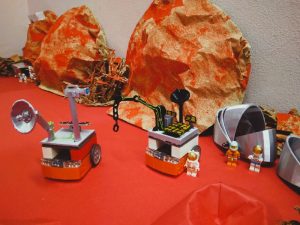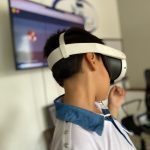Per Marte si parte! by I Roverati
Nuova Educazione Milano-Lombardia Włochy 10 lat 18 / 6 Włoski Mars
Link zewnętrzny do projektu Tinkercad 3D
Opis projektu
Siamo stati la seconda missione umana inviata su Marte. Scherziamo! Siamo i bambini di una classe V della scuola Primaria, ma dopo aver partecipato a “Qui base Marte Schiapparelli” presso il Museo della Scienza e della Tecnologia di Milano siamo un po’ entrati nella parte e ci siamo tanto appassionati alle missioni spaziali e il nostro progetto è partito. Abbiamo avuto l’aiuto di alcuni papà, uno ci ha spiegato come funzionava Tinkercad e un altro ci ha dato lezioni di programmazione dei robottini Edison presenti a scuola. Poi è toccato a noi, prima singolarmente e poi divisi in 4 gruppi, abbiamo progettato i nostri rover con Tinkercad, ognuno con un compito specifico da svolgere su Marte. I primi due rover sono esploratori, il loro compito è trivellare la superficie del pianeta e raccogliere campioni. Il terzo ha il compito di ricercare acqua, anche in forma ghiacciata. L’ultimo è l’unico ad essere direttamente manovrato da esseri umani il cui compito è fare esperimenti e ricercare tracce di vita sul pianeta. E’ quindi venuto il momento di stampare quello che avevamo progettato. All’inizio non è andato tutto bene, facevamo partire la stampante 3d che il papà aveva portato a scuola e al mattino trovavamo delle vere esplosioni di materiale. Il filo non andava bene per realizzare pezzi così piccoli e quando lo abbiamo cambiato tutto poi è proceduto al meglio. Nel frattempo abbiamo anche imparato a programmare i nostri robottini e con le maestre abbiamo pensato di cercare di ricreare un ambiente “marziano” in cui farli muovere. Abbiamo disegnato mappe che le maestre hanno cercato di unificare in un unico progetto finale che contiene un po’ le idee di tutti, siamo un team: “I Roverati”. Ognuno di noi ha realizzato un pezzo del plastico, a seconda delle proprie abilità: chi ha disegnato la Base, chi ha realizzato le serre, i radiotelescopi, l’impianto con i pannelli fotovoltaici. Un bambino bravissimo a fare origami ha realizzato i crateri e i due razzi che la base utilizza per i rifornimenti. Abbiamo dipinto di rosso della carta e anche dei trucioli per realizzare dei rilievi. Per creare un po’ di effetto 3d nel disegno della base abbiamo realizzato anche gli hangar da cui escono i rover. Vedrete le foto del nostro plastico e dei rover e anche un filmato su you tube, con i robottini in movimento. Anche questo non è stato affatto facile, bastava pochissimo a far cambiare direzione ai nostri rover e fare in modo che non si scontrassero ha richiesto molte prove e aggiustamenti dei programmi. E’ stato un lavoro che ci ha impegnati per diversi mesi e ci sembra ovvio ma lo diciamo lo stesso ci è piaciuto molto e pensiamo anche di aver imparato un po’ di cose. Ma non è finita. Con la maestra di italiano abbiamo anche scritto una poesia su Marte e con l’insegnante di teatro l’abbiamo animata e recitata. Insomma siamo proprio pronti per partire di nuovo per Marte!
I Roverati
Tłumaczenie na język angielski
We were the second human mission sent to Mars. Let’s joke! We are the children of a fifth class of primary school, but after having participated in “Qui base Marte Schiapparelli” at the Museum of Science and Technology in Milan we got into the role a bit and we became very passionate about space missions and our project has started. We had the help of some dads, one explained to us how Tinkercad worked and another gave us lessons in programming the Edison robots present at school. Then it was our turn, first individually and then divided into 4 groups, we designed our rovers with Tinkercad, each with a specific task to carry out on Mars. The first two rovers are explorers, their job is to drill into the surface of the planet and collect samples. The third has the task of searching for water, even in frozen form. The last one is the only one to be directly operated by human beings whose task is to carry out experiments and search for traces of life on the planet. The time then came to print what we had designed. At the beginning everything didn’t go well, we started the 3D printer that dad had brought to school and in the morning we found real explosions of material. The thread wasn’t good for making such small pieces and when we changed it everything worked fine. In the meantime we also learned to program our little robots and with the teachers we thought about trying to recreate a “Martian” environment in which to make them move. We designed maps that the teachers tried to unify into a single final project that contains everyone’s ideas, we are a team: “I Roverati”. Each of us created a piece of the model, depending on our skills: who designed the Base, who created the greenhouses, the radio telescopes, the system with the photovoltaic panels. A child who is very good at origami created the craters and the two rockets that the base uses for supplies. We painted some paper and also some shavings red to make reliefs. To create a bit of a 3D effect in the design of the base we also created the hangars from which the rovers come out. You will see photos of our model and the rovers and also a film on YouTube, with the robots in motion. Even this wasn’t easy at all, it took very little to make our rovers change direction and ensuring that they didn’t collide required a lot of testing and program adjustments. It was a job that occupied us for several months and it seems obvious to us but we say it anyway, we liked it a lot and we also think we learned a few things. But it’s not over. With the Italian teacher we also wrote a poem about Mars and with the theater teacher we animated and recited it. In short, we are really ready to leave for Mars again!
The Roverati
Tinkercad link 1
Tinkercad link 2
Tinkercad link 3
Tinkercad link 4
Tinkercad link 5
Tinkercad link 6
Tinkercad link 7
Film z projektu
#
Sztuka i rzemiosło #
Projekt 3D #
Druk 3D #
Robotyka #
Inne
Inne projekty
Juan Bautista Garcia’s Project
































